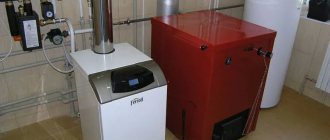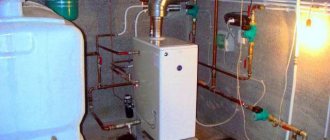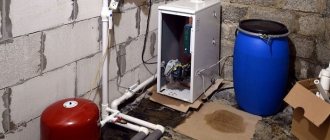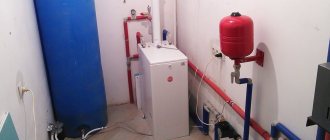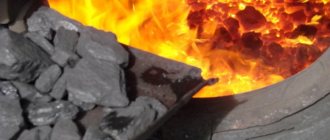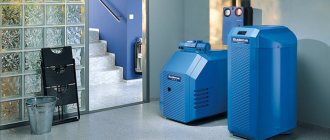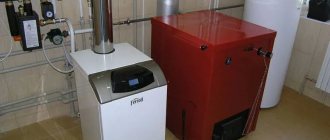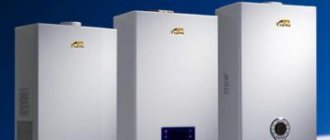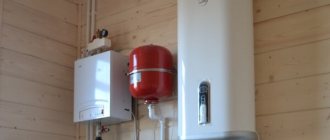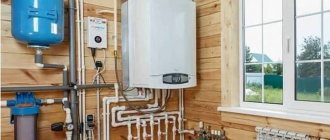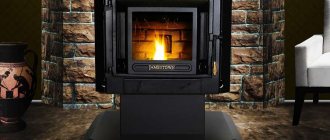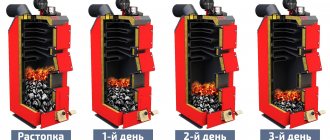Heating devices that operate on diesel fuel are ideal for heating and hot water supply not only for private homes, but also for industrial facilities. Boilers of this type are easy to use, they do not require special care, and most importantly, they are durable (the service life reaches 25 years).
Diesel heating boiler fuel consumption
- 1 Fuel consumption for various boiler models
- 2 What will fuel consumption depend on?
- 3 Fuel consumption
- 4 How to save on fuel? Criteria for choosing heating equipment 4.1 Video – Diesel heating boiler – fuel consumption
- 7.1 Video – Diesel boilers
Fuel consumption for various boiler models
We conducted a small comparative analysis of various models of diesel boilers in order to show you their average fuel consumption.
| Make and model | Photo | Max heating area m2 | DHW performance | Max fuel consumption | Weight kg | Max power kW | Manufacturer |
| Kiturami TURBO-21 R (floor-standing diesel boiler) | 245 | 14 l/min | 2,8 | 58 kg | 24.4 kW | Korea | |
| NAVIEN LST-50KR | 500 | 28.7 l/min | 5,8 | 94 kg | 50 kW | Korea | |
| NAVIEN LST-24K | 240 | 13.8 l/min | 2,9 | 40 kg | 24 kW | Korea | |
| Buderus Logano G225-78 SE | 780 | — | 7.2 | 336 | 78 kW | Germany |
Additional criteria © Single-circuit or double-circuit
| Fuel consumption of a diesel heating boiler. So, you have decided to install a boiler for heating a private house using diesel fuel and, for starters, you want to find out how much diesel fuel it will consume. availability of free access to diesel fuel or the opportunity to purchase it at a favorable price from agricultural enterprises, tractor drivers, KAMAZ or bus drivers; |
- high power, allowing them to maintain a comfortable temperature in cottages of large areas;
- Efficiency exceeding 90% for most models;
- possibility of installation without obtaining additional permits (as for electric or gas boilers);
- inexpensive and widespread fuel;
- the ability of diesel boilers to switch to gas by replacing the burner.
Fuel consumption per day at average t +5-10 degrees • Fuel consumption increases at maximum load.
What will fuel consumption depend on?
There are a number of factors (including various loads) that influence the performance of heating equipment. But first of all this:
- area of the heated room;
- quality of thermal insulation of the building.
Of course, the larger the room itself, the greater the diesel fuel consumption will be. As for the efficiency of the equipment described, in most cases it varies between 90 and 95 percent. But, which is typical, to achieve this result, the speed during operation of the boiler must be maximum. Therefore, when choosing a heating device, you should not purchase a model whose power has a small reserve. This way you will be able to avoid unnecessary expenses, since here the liquid fuel boiler will consume less diesel fuel.
Recommendations for calculating the heating system of a private house
Before assembling a heating system in a private home, you will need information about the exact amount of thermal energy. There are two methods of calculation - simple approximate and exact calculation. The first option, due to its simplicity and ensuring the correct result, is usually used by heating equipment distributors. In this case, to calculate the thermal power, parameters of the area of the premises that need to be heated are necessary.
A separate room is taken, its area is calculated, after which the result is multiplied by 100 W. Having determined the parameter for each room in this way, all indicators are ultimately summed up to obtain a total value.
For a more accurate calculation, additional indicators are used:
- To multiply by 100 W, the parameters of rooms with one wall in contact with the street and having one window opening are taken.
- Corner rooms with one window are multiplied by 120 watts.
- The area of a room with two external walls and two or more windows should be multiplied by 130 W.
If an approximate method is used to calculate the required power of a home heating system, this may lead to a shortage of home heating for residents of the northern regions. At the same time, residents of the southern regions with this approach to calculation will overpay for overly powerful devices. The second (calculation) method is usually used by design specialists. Thanks to greater accuracy, it allows you to determine the level of heat loss through the walls of a building.
Before starting the calculation, measure the house, calculating the area of walls, windows and doors. Next, the thickness of each of the building materials used for the construction of walls, floors and ceilings is determined. Each of these materials has a certain thermal conductivity coefficient, expressed in units of W/(m · ºС). It is substituted into the formula for calculating the thermal resistance R (m2 ºС / W): R = δ / λ, here δ is the thickness of the wall material in meters.
To calculate the amount of heat loss through external walls, use the formula QТП = 1/R x (tв – tн) x S, where:
- QТП – amount of heat loss, W;
- S – room area, m2;
- tв – expected internal temperature;
- tн – street temperature in the coldest period
The calculation procedure is carried out individually for each room in the house, for which the thermal resistance and area indicators for the outer wall, window, door, floors and roof are substituted into the formula in turn. Next, all the obtained parameters must be added up, which will make it possible to obtain the overall heat loss indicator. In this case, internal partitions are not taken into account.
Fuel consumption
The main reason for the widespread use of boilers that consume diesel fuel is its low consumption. When calculating the power of the device, you should base it on the energy consumption required to heat the water. The approximate consumption of a diesel heater is 10 kilowatts per liter of fuel if the efficiency is 91 percent. The cost of diesel fuel today is approximately 32 rubles, therefore, this is how much every 10 kilowatts of energy will cost.
Now let’s compare how much power is required for electric boilers. The efficiency of this equipment is on average 95 percent. The cost of 1 kilowatt of electrical energy is 5 rubles, which means 10 kilowatts will cost about 50 rubles. The conclusion is obvious: a diesel heating boiler has approximately half the fuel consumption.
Note! If diesel fuel is used as fuel, then calculations should be made as follows. The burner power must be multiplied by the indicator = 0.1. This will allow you to calculate the amount of fuel consumed per hour of operation. Typically, the result of these calculations is measured in kilograms.
Let's give a small example. Let's say the area of the heated room is 200 square meters. And to heat such a room, you will need a diesel boiler with a capacity of 20 kilowatts. We multiply this figure by the above-mentioned figure of 0.1 and get 2. It turns out that this is exactly how many kilograms of diesel fuel the unit needs for an hour of continuous operation at maximum power. If we talk about consumption per day, then in this case it will be equal to 48 kilograms. It's simple.
The duration of the heating season is on average one hundred days per year. During all this time, the heating equipment will operate at maximum power, so it will require the maximum amount of fuel (for us this is diesel fuel). Over the entire hundred days, the boiler uses 4,800 kilograms of fuel.
Standards and requirements for a boiler room in a private house
We advise you to read our guide about what requirements must be met in order to equip a boiler room in a private house, see details here
As you can see, despite the fact that the cost of electric and diesel appliances is different, the amount of thermal energy in both cases is practically the same. The conclusions are obvious, there is nothing special to talk about. And if you want to save on heating, then you can safely purchase a diesel boiler!
Note! As you know, when diesel fuel burns, it produces a large amount of soot and soot. And if the thickness of soot deposits is, for example, 2 millimeters, then fuel consumption will increase by about 8 percent because of this. For this reason, it is recommended to periodically clean the heating device.
How to select the power and type of radiator switching
Before installing central heating in a private house, you need to decide on the number of sections and dimensions of the panel radiator.
In order for these calculations to be optimal, you need to know the amount of heat. How to determine it has already been said above, but a couple of points require clarification. For example, the heat transfer of a section is indicated by the manufacturer for conditions when the temperature difference between the coolant and the air in the room is 70 degrees. This is achieved only when the water in the system is heated to +90 degrees, and this is not common. It turns out that the actual thermal power will be noticeably inferior to that indicated in the passport. For this reason, for normal heating of a home, radiators with one and a half heat transfer margin are used. For example, when a room needs 2 kW of heat, heating devices with a capacity of at least 2 x 1.5 = 3 kW will be required.
Several methods are used to connect radiators with risers:
- lateral one-sided;
- diagonal scalene;
- lower.
How to save on fuel? Criteria for choosing heating equipment
Units consuming liquid fuel are designed for both one and two circuits. And it is quite obvious that in the second case, fuel consumption will be greater, which will only increase costs. For this reason, the best option for dual-circuit appliances can only be to reduce the consumption of hot water, which will help save on fuel.
Experts advise one more thing. According to them, fuel consumption can also be reduced by setting a lower temperature for the coolant. And the final point - it is advisable to install a thermostat in the warmest room. If you follow all these recommendations, you will be able to reduce the fuel consumption required for the operation of the boiler and save a certain amount of money.
On many thematic forms, users are interested in: which units are more economical - diesel or electric? And what is the general fuel consumption of a diesel heating boiler? It is quite difficult to answer this question unambiguously, since it depends on a number of factors, including:
- quality of building thermal insulation;
- cost of the fuel used;
- area of the heated room;
- features of a specific climate zone;
- number of residents in the house.
And if you know about all these factors, then you can roughly calculate the consumption of both fuels by comparing costs. And now - some more practical advice regarding the choice of a heating unit.
- Heating equipment that consumes diesel fuel, if there is a combustion chamber made of steel, will be immune to temperature changes. At the same time, steel undergoes a rusting process, so it does not last as long as, for example, cast iron.
- The higher the cost of a heating boiler, the higher the risk that its maintenance will cost you very much (when compared with models that have a lower cost).
- Devices that are equipped with a cast iron combustion chamber can last up to twenty years, but temperature changes affect them quite significantly. In this kind of heating systems, it is necessary to install valves that will mix the heated liquid into the return pipeline. All this is required so that the combustion chamber simply does not split.
Video – Diesel heating boiler – fuel consumption
Why diesel fuel?
When choosing a heating boiler, each user is guided by specific individual requirements. And if you, for example, live in a locality where there is no centralized gas supply or there are frequent fluctuations in the power supply, then diesel fuel boilers, the consumption of which, as we have already found out, is insignificant, will be the most optimal option.
Moreover, such devices have one more advantage that we did not talk about - the fuel container can be installed in any place convenient for you. And this has become a decisive factor for the fact that the popularity of diesel equipment has only been increasing in recent years.
Alternative home heating with diesel fuel
What could I do to make heating my home with diesel a little less expensive, so that I could use a diesel boiler as the main source of heat for my home?
The first thing I think of is using a waste oil burner. I install such a burner during testing and collect virtually free fuel wherever I can - at service stations, at express oil change kiosks, and so on.
What are the disadvantages of this option? The first and most basic is the price of the burner. The cost of the burner during testing is 60,000 rubles. Which is comparable to purchasing almost 2 tons of diesel fuel.
Secondly, the waste also needs to be collected, waste of gasoline and time, transport it in cans to the house, settle it somewhere and store it during this time.
And thirdly, I’m not the only one who is so smart. More than once I have watched my comrades collect waste from the service station and take it away for their own needs. This is exactly the same issue as with making your own pellets. It seems like the sawdust is free. But in fact, it turns out that it is easier to heat with briquettes than to make pellets yourself from “free” sawdust.
There is, of course, also diesel oil and light oil. But there are also pitfalls there. Starting from the fact that a standard burner will not be guaranteed to work on these types of fuel, and ending with the complete impossibility of obtaining this fuel in some regions.
Here an analogy with the Karborobot coal boiler suggests itself. The boiler is good, no doubt about it. But in our region there is no fuel for it, there is no coal of the required fraction, there are no good suppliers. And bringing it from somewhere is incredibly expensive.
autoruMAX » March 05, 2012, 18:39
Good afternoon, the problem has arisen of organizing a boiler room in the domain, you need to choose a 30 kW diesel boiler; an electric one of 12 kW will work in tandem with it (which is better?) water gun for 8 circuits - 5 for heating - pool heat exchanger - heated floor 1 circuit for an area of 70 mkv
The main question regarding a diesel boiler is which one is better, which chimney is better for it? (height from boiler room to ridge 14m - there is room for a chimney - shaft 1.5x0.7m)
how to connect boilers?
in the future (in 3-4 years it is possible to switch to main gas) and increase the area from 300 to 500 sq.
water supply is separate - completely on an electric boiler 300 l (what a good one - for a few tenns and spare parts if anything is easy to buy)
For a diesel boiler, the most important parameter is problem-free and so that you can, for example, buy a couple of burners and change them as needed
Sorry, forum members, please, does anyone have such a device, I would like to know how much fuel it consumes per day, how it works, how much area it heats. I have a house on the 2nd floor, 160 square meters, lined with brick, mp windows, maybe someone knows which is the most economical of the famous brands, please write here or on soap. Thank you in advance
Why did you choose diesel equipment?
All I know is that fuel consumption is from two liters per hour and above. It would also be interesting to hear what knowledgeable people have to say.
uv Semyon, we don’t have mains gas and normal voltage, we only have liquid fuel, since we need to heat when there is no one at home, if there was someone all the time, we would heat with wood
The fact is that you will need electricity in any case for the operation of automation and pumps. Simply, my personal opinion is that it is possible to find an alternative to diesel fuel in the absence of main gas. It will be more environmentally friendly and cheaper to maintain. Unfortunately, you can’t write in detail here, it will be considered advertising.
It's cheaper to hire a fireman.
SemyonSV, you really intrigued me. Admit what alternative there is to diesel fuel, besides gas and an electric boiler. (firewood and coal do not count, as they require constant presence).
An alternative is wood pellets, which are produced by drying and hot pressing wood processing waste without the use of binders. Moreover, this type of fuel is produced to a greater extent in Russia, but is used to a large extent in Europe, because Their traditional energy sources are expensive. Due to their qualities, granules are an environmentally friendly type of fuel, and the ash residue is no more than 1%.
Pellet boiler houses are quite expensive, compared, for example, with diesel boilers - 2-2.5 times more expensive. But if you calculate maintenance costs and fuel costs, then pellets are more profitable.
Everything that was written here was not for advertising purposes, but only for clarification on the question asked.
Features of liquid fuel equipment
Boilers that consume diesel fuel, diesel fuel or kerosene can be used, as already noted, for domestic and industrial buildings. Fuel must be stored in a special container - it can be located anywhere, as long as it is convenient:
- underground;
- in the boiler room;
- in the courtyard.
And this is precisely one of the main advantages of the described equipment.
Note! It is most advisable to use these boilers in non-gasified settlements, because the fuel consumption in this case is quite low. As for the principle of operation, it is not much different from devices that consume other types of fuel.
The device includes a combustion chamber where the burner is located; with the help of the latter the fuel is burned. During operation, the coolant warms up, after which it is supplied to the heating system. A traditional chimney is used to remove combustion products. Typically, when moving, they are passed through a heat exchanger, sharing part of the thermal energy with it. This allows you to significantly increase efficiency.
Devices operating on diesel fuel, in most cases, have a body made of steel - it is known to be practically impervious to rust. Under the body there are automation units (they control the functioning of the boiler) and control units of the device. In the manufacture of heat exchangers, either cast iron or steel is used; Thanks to this, the units are able to withstand exposure to critical temperatures for a long time.
In order to reduce heat loss during operation, as well as in order to reduce the amount of diesel fuel consumed by the boiler, a thermal insulating gasket is installed under its outer casing, which at the same time prevents accidental burns when touching the surface.
Single pipe system
And the most common of those myths is about the single-pipe heating scheme. The coolant is directed to the radiators and back through one pipe, and many people believe that this is an ideal option for a small house, as it is cheaper to maintain than other variations. But that's not true.
Due to the fact that all the batteries are connected to one pipe, the efficiency drops noticeably, and the radiator at the end of the chain differs significantly in temperature from those at the beginning. This leads to a forced increase in boiler power and, as a consequence, to an increase in fuel consumption.
However, this scheme remains popular due to the low cost of the installation itself. A small number of structural elements allows you to save on materials, and in small rooms, temperature losses at the extreme points of the circuit are not so important; they are leveled out by natural air circulation.
Diesel boilers - industrial use
Industry can use equipment that consumes different types of liquid fuel, namely:
- diesel fuel;
- working out;
- fuel oil
The most efficient fuel in production conditions is considered to be waste fuel – that is, used engine oil. Here, a diesel heating boiler has low fuel consumption; Moreover, oil, as is known, should be disposed of after use. And if you use it in diesel boilers, you will not only be able to get practically free high-quality fuel, but you will also do your bit to protect the environment.
Often, industrial facilities use diesel heating equipment, which is also capable of producing the steam needed in production. Each such unit has high power and an automatic system that eliminates condensation; There is also an economizer, which significantly increases efficiency. Thanks to their high power, they can be used to heat various utility rooms, and even entire industrial workshops.
Circuit mounting options
The main pipeline transporting the coolant can not only have different configurations, called wiring, but also be installed differently.
When choosing an installation option, you should take into account aesthetic, energy and economic feasibility.
The installation of the highway can be done in two ways: open or hidden:
- The open installation method is simpler and cheaper - the circuit is laid in accordance with the selected wiring diagram, and the only additional work required is to secure the pipes to prevent their deformation. In addition, in this case, the main line, in addition to transporting the coolant, also performs a heat transfer function, that is, it additionally heats the premises. At the same time, a pipeline left in sight spoils the interior, it is not protected from external damage and is itself a source of danger: you can get burned on it, flammable materials left nearby can ignite, and if the pipeline ruptures, not only damage to the external and internal decoration of the room, but also there is a risk of injury.
- Installing a pipeline in a hidden way involves laying pipes in channels made in the wall, floor, under the baseboard or behind the suspended ceiling. A simplified option is to make a false wall or use boxes and various pipe covers. Concealed installation ensures safety and looks more aesthetically pleasing.
Choosing the optimal burner
Typically, the process of selecting a diesel burner is carried out by the boiler equipment manufacturer. If the boiler is supplied without it, then the boiler passport must indicate the exact characteristics of the LTG, from geometric to thermal, allowed for installation.
For low-power diesel boilers used for heating and hot water supply of small-sized objects, it is allowed to select the burner device independently, taking into account the following parameters:
- The thermal power of the burner must correspond to the thermal power of the boiler.
- The geometric characteristics of the device should allow its installation on the front panel of the boiler, while the dimensions of the torch in maximum mode should not touch its walls and heating surfaces.
- The type of regulation should be modulated in the range of 10-100%.
- The fuel system must have a diesel storage tank, a heater and a transfer pump.
Classification
The choice of model depends on the set of necessary characteristics: power, heat exchanger material, type of combustion implemented in the boiler, as well as the need for hot water supply.
Power selection
The most important characteristic, the correct choice of which determines heating efficiency and economical fuel consumption. The power of diesel heating equipment is measured in kilowatts; it is indicated in the technical documentation for any boiler. There is a special method for calculation that takes into account all the nuances.
It is more convenient for an ordinary consumer to focus on the area of a heated private house - this indicator is also indicated in the main characteristics of any model. As a rule, for a temperate climate you can use a simple formula: the total area of all rooms in the house is divided by ten, the result is the required boiler power. For colder climates, this value should be increased by 20-30%.
A simplified method of calculating power is relevant only for houses with a simple layout with a ceiling height of up to 3 m. For multi-storey buildings with heated staircases, it is better to calculate based on the volume of the premises.
Fuel consumption calculation
Diesel fuel consumption directly depends on the boiler power; on average, it is calculated as follows: the boiler power in kilowatts is divided by 10, and the hourly diesel fuel consumption in kg in heating mode is obtained. In temperature maintenance mode, consumption is reduced by 30-70% depending on the degree of thermal insulation of the house. On average, the consumption of domestic heating boilers in a medium-sized private house is 0.5-0.9 kg.
Heat exchanger material - what depends on it?
The heat exchanger in diesel boilers can be made of steel or cast iron. Both materials have both advantages and disadvantages:
- boilers with a steel heat exchanger are lighter and cheaper, react faster to temperature changes, and are more resistant to local overheating, but they are highly susceptible to corrosion;
- a heat exchanger made of stainless steel is durable, is not afraid of the effects of aggressive compounds, has uniform heat distribution, and the price is slightly higher;
- the price of boilers with a cast iron heat exchanger is higher, they are heavier, are more fragile and can crack under sudden temperature changes, but they are more resistant to corrosion and durable when used in an aggressive environment;
When diesel fuel burns, a large amount of soot containing sulfur compounds is formed. Combining with condensate, they form weak acids, which leads to rapid corrosion of the boiler elements and its failure.
The appearance of condensation can be avoided by using a properly installed return supply system to the boiler, which will be discussed in the corresponding section.
Single or double circuit?
Diesel boilers for a private home can not only provide heating, but also heat water for domestic needs. Such boilers are called double-circuit boilers. When choosing a double-circuit boiler, it is necessary to increase the design power by 20%, otherwise it may not be enough for efficient heating and water heating.
When purchasing, you need to evaluate the feasibility of purchasing a dual-circuit model; if the hot water consumption is insignificant, it is better to install a separate water heater and not complicate the heating system.
Heat generation method - which is better?
Based on the principle of heating the coolant, diesel boilers come in traditional types and condensing boilers, which additionally use condensate energy. They offer increased efficiency and lower fuel consumption, but they come at a higher price.
Do you need a replacement burner?
Diesel burners are very similar in design to gas burners, so there are many models on the market that allow you to use any of these burners in one boiler. Replacing them is so simple that it does not require calling a technician - you can do it yourself at a convenient time.
If a diesel boiler is purchased as a temporary source of heating, and it is planned to connect to the gas mains in the foreseeable future, it is better to choose a model adapted to replaceable burners.
Emissions of pollutants when refueling emergency refueling
The thing is that for 2022 it was indicated that the standards established by the Ministry of Transport of the Russian Federation are not mandatory, but only recommended. Therefore, an enterprise accountant can decide for himself how best to calculate fuel consumption.
Device benefits
- high power level and temperature indicators;
- significantly reduced price, in contrast to the cost of gas heating;
- compatible with most boilers;
- constant level of combustion;
- no need to obtain permission for installation;
- quick installation capabilities;
- high efficiency;
- non-stop work up to 16 hours;
- Possibility of use in places with different temperature conditions, where there is no central heating supply;
- ease of maintenance and repair;
- almost silent operation;
- built-in security system.
When a diesel burner operates, liquid fuel is mixed with air. Next, the mixture is supplied to the combustion site. After starting the device, the pump gradually builds up pressure to 16 bar. Then, using nozzles, the fuel is sprayed and mixed with air. At the end of the process, the particles enter a chamber where combustion occurs.
Modern burners are equipped with a combustion control system. Monitoring is carried out using a microprocessor equipped with the unit. Fuel preheating is also possible, making operation possible even at -45 degrees Celsius.
DIY burner installation
Installation of the burner should be carried out by experienced professionals, especially if the gas generator and the boiler are under warranty.
However, during operation, situations often arise when operating personnel must install the LTG with their own hands. This process is multi-stage and consists of the following stages:
- installation of control valves on the fuel supply line in front of the burner;
- installation of liquid fuel gas on the front panel of the boiler;
- connecting electrical connectors and ramps;
- installation of a diesel fuel sprayer;
- nozzle installation;
- starting the burner;
- setting up and testing the combustion process with a gas analyzer.
Connection to the power line is carried out according to the electrical diagram specified by the manufacturer in the instructions. When installing fuel lines, their length must be selected in such a way that it is possible to tilt the burner device while servicing the boiler.
Electronic controllers are very susceptible to voltage surges, and therefore it is recommended to connect them to the mains through a stabilizer. In this case, the device will operate for the entire design period and unscheduled repairs of diesel burners will not be required.
Burner setup and maintenance
Setting up the diesel burner for Lamborghini, Lamborghinieco 15, Lamborghinieco 3 and other Western modifications is carried out according to regime maps in accordance with factory instructions. Operation control is carried out using a gas analyzer, measuring the composition of flue gases in front of the smoke exhauster for the content of CO, CO2 and O2.
During the operation of the gas turbine generator, mandatory maintenance is performed according to the technological maps in order to maintain the unit in working condition. As a rule, maintenance is performed at least once a year.
If necessary, repair diesel burners and replace parts located in the combustion zone: nozzles or sprayers. During the maintenance process, the surface of the device is cleaned from soot, filters and worn parts of the injector and nozzles are replaced.
